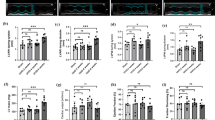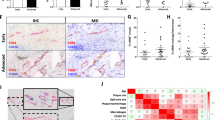Abstract
Fabry disease is a glycosphingolipidosis caused by deficient activity of α-galactosidase A; it is one of a few diseases that are associated with priapism, an abnormal prolonged erection of the penis. The goal of this study was to investigate the pathogenesis of Fabry disease-associated priapism in a mouse model of the disease. We found that Fabry mice develop late-onset priapism. Neuronal nitric oxide synthase (nNOS), which was predominantly present as the 120-kDa N-terminus-truncated form, was significantly upregulated in the penis of 18-month-old Fabry mice compared to wild type controls (~fivefold). Endothelial NOS (eNOS) was also upregulated (~twofold). NO level in penile tissues of Fabry mice was significantly higher than wild type controls at 18 months. Gene transfer-mediated enzyme replacement therapy reversed abnormal nNOS expression in the Fabry mouse penis. The penile nNOS level was restored by antiandrogen treatment, suggesting that hyperactive androgen receptor signaling in Fabry mice may contribute to nNOS upregulation. However, the phosphodiesterase-5A expression level and the adenosine content in the penis, which are known to play roles in the development of priapism in other etiologies, were unchanged in Fabry mice. In conclusion, these data suggested that increased nNOS (and probably eNOS) content and the consequential elevated NO production and high arterial blood flow in the penis may be the underlying mechanism of priapism in Fabry mice. Furthermore, in combination with previous findings, this study suggested that regulation of NOS expression is susceptible to α-galactosidase A deficiency, and this may represent a general pathogenic mechanism of Fabry vasculopathy.




Similar content being viewed by others
References
Backenroth R, Landau EH, Goren M, Raas-Rothschild A (2010) Fabry disease and G6PD in three family members with priapism: is the nitric oxide pathway to blame? J Sex Med 7:1588–1591
Bivalacqua TJ, Musicki B, Kutlu O, Burnett AL (2012) New insights into the pathophysiology of sickle cell disease-associated priapism. J Sex Med 9:79–87
Bodary PF, Shen Y, Vargas FB et al (2005) Alpha-galactosidase a deficiency accelerates atherosclerosis in mice with apolipoprotein E deficiency. Circulation 111:629–632
Brady R, Gal AE, Bradley RM, Martensson E, Warshaw AL, Laster L (1967) Enzymatic defect in Fabry disease: ceramide trihexosidase deficiency. N Engl J Med 276:1163–1167
Burnett AL (2004) Novel nitric oxide signaling mechanisms regulate the erectile response. Int J Impot Res 16(Suppl 1):S15–S19
Champion HC, Bivalacqua TJ, Takimoto E, Kass DA, Burnett AL (2005) Phosphodiesterase-5A dysregulation in penile erectile tissue is a mechanism of priapism. Proc Natl Acad Sci U S A 102:1661–1666
Christodoulou J, Dewan PA, Tan HL, Rogers JG (1988) Priapism: a rare complication of Fabry's disease. Pediatr Surg Int 4:69–70
Desnick RJ, Ioannou YA, Eng CM (2001) a-Galactosidase A deficiency: Fabry disease. In: Scriver CR, Beaudet AL, Sly WS, Valle D (eds) The metabolic and molecular bases of inherited disease. McGraw-Hill, New York, pp 3733–3774
Endres W, Shin YS, Rieth M, Block T, Schmiedt E, Knorr D (1987) Priapism in Fabry's disease during testosterone treatment. Klin Wochenschr 65:925
Foda MM, Mahmood K, Rasuli P, Dunlap H, Kiruluta G, Schillinger JF (1996) High-flow priapism associated with Fabry's disease in a child: a case report and review of the literature. Urology 48:949–952
Garcia-Consuegra J, Padron M, Jaureguizar E, Carrascosa C, Ramos J (1990) Priapism and Fabry disease: a case report. Eur J Pediatr 149:500–501
Ghosh AK, Vaughan DE (2012) PAI-1 in tissue fibrosis. J Cell Physiol 227:493–507
Gonzalez CM, Brannigan RE, Bervig T et al (2001) Protein and gene expression of nitric oxide synthase isoforms I and III in the rat penile shaft. J Androl 22:54–61
Huang YC, Harraz AM, Shindel AW, Lue TF (2009) Evaluation and management of priapism: 2009 update. Nat Rev Urol 6:262–271
Jung HC, Mun KH, Park TC et al (1997) Role of nitric oxide in penile erection. Yonsei Med J 38:261–269
Kang JJ, Shu L, Park JL, Shayman JA, Bodary PF (2014) Endothelial nitric oxide synthase uncoupling and microvascular dysfunction in the mesentery of mice deficient in alpha-galactosidase a. Am J Physiol Gastrointest Liver Physiol 306:G140–G146
Lagoda G, Sezen SF, Hurt KJ, Cabrini MR, Mohanty DK, Burnett AL (2014) Sustained nitric oxide (NO)-releasing compound reverses dysregulated NO signal transduction in priapism. FASEB J 28:76–84
Mi T, Abbasi S, Zhang H et al (2008) Excess adenosine in murine penile erectile tissues contributes to priapism via A2B adenosine receptor signaling. J Clin Invest 118:1491–1501
Moore DF, Scott LT, Gladwin MT et al (2001) Regional cerebral hyperperfusion and nitric oxide pathway dysregulation in Fabry disease: reversal by enzyme replacement therapy. Circulation 104:1506–1512
Ning C, Wen J, Zhang Y et al (2014) Excess adenosine A2B receptor signaling contributes to priapism through HIF-1alpha mediated reduction of PDE5 gene expression. FASEB J 28:2725–2735
Penson DF, Ng C, Cai L, Rajfer J, Gonzalez-Cadavid NF (1996) Androgen and pituitary control of penile nitric oxide synthase and erectile function in the rat. Biol Reprod 55:567–574
Puri V, Watanabe R, Dominguez M et al (1999) Cholesterol modulates membrane traffic along the endocytic pathway in sphingolipid-storage diseases. Nat Cell Biol 1:386–388
Qu XW, Wang H, Rozenfeld RA, Huang W, Hsueh W (1999) Type I nitric oxide synthase (NOS) is the predominant NOS in rat small intestine. Regulation by platelet-activating factor. Biochim Biophys Acta 1451:211–217
Reilly CM, Zamorano P, Stopper VS, Mills TM (1997) Androgenic regulation of NO availability in rat penile erection. J Androl 18:110–115
Schiffmann R (2009) Fabry disease. Pharmacol Ther 122:65–77
Schirar A, Bonnefond C, Meusnier C, Devinoy E (1997) Androgens modulate nitric oxide synthase messenger ribonucleic acid expression in neurons of the major pelvic ganglion in the rat. Endocrinology 138:3093–3102
Shen JS, Arning E, West ML et al (2017) Tetrahydrobiopterin deficiency in the pathogenesis of Fabry disease. Hum Mol Genet 26:1182–1192
Shen JS, Meng XL, Wight-Carter M et al (2015) Blocking hyperactive androgen receptor signaling ameliorates cardiac and renal hypertrophy in Fabry mice. Hum Mol Genet 24:3181–3191
Toda N, Ayajiki K, Okamura T (2005) Nitric oxide and penile erectile function. Pharmacol Ther 106:233–266
Wang Y, Goligorsky MS, Lin M, Wilcox JN, Marsden PA (1997) A novel, testis-specific mRNA transcript encoding an NH2-terminal truncated nitric-oxide synthase. J Biol Chem 272:11392–11401
Ziegler RJ, Cherry M, Barbon CM et al (2007) Correction of the biochemical and functional deficits in fabry mice following AAV8-mediated hepatic expression of alpha-galactosidase a. Mol Ther 15:492–500
Acknowledgements
We thank Sean C. Goetsch and Misty N. Demaree (University of Texas Southwestern Medical Center, Dallas), Deborah L. Berry (Georgetown University Medical Center, Washington D.C.) and Dilechia Hawthorne (Baylor Research Institute, Dallas) for their technical assistance. We thank Marie-Anne Schiffmann for editing and proofing the manuscript. This work was supported by the Baylor Scott & White Research Institute Foundation.
Funding
This work was supported by the Baylor Scott & White Research Institute Foundation. The authors confirm independence from the sponsors; the content of the article has not been influenced by the sponsors.
Author information
Authors and Affiliations
Corresponding author
Ethics declarations
Conflict of interest
X.-L. Meng, E. Arning, M. Wight-Carter, T. S. Day, S. Jabbarzadeh-Tabrizi, S. Chen, R. J. Ziegler, T. Bottiglieri, J. W. Schneider, S. H. Cheng, R. Schiffmann, and J.-S. Shen declare that they have no conflict of interest.
Animal rights
All institutional and national guidelines for the care and use of laboratory animals were followed. All animal procedures were reviewed and approved by the Institutional Animal Care and Use Committee of Baylor Research Institute.
Additional information
Communicated by: Markus Ries
Electronic supplementary material
ESM 1
(DOCX 2461 kb)
Rights and permissions
About this article
Cite this article
Meng, XL., Arning, E., Wight-Carter, M. et al. Priapism in a Fabry disease mouse model is associated with upregulated penile nNOS and eNOS expression. J Inherit Metab Dis 41, 231–238 (2018). https://doi.org/10.1007/s10545-017-0107-6
Received:
Revised:
Accepted:
Published:
Issue Date:
DOI: https://doi.org/10.1007/s10545-017-0107-6




